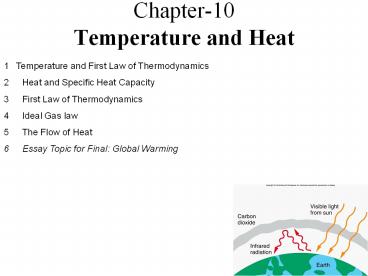Chapter-10 Temperature and Heat - PowerPoint PPT Presentation
Title:
Chapter-10 Temperature and Heat
Description:
Chapter-10 Temperature and Heat 1 Temperature and First Law of Thermodynamics Heat and Specific Heat Capacity First Law of Thermodynamics Ideal Gas law – PowerPoint PPT presentation
Number of Views:913
Avg rating:3.0/5.0
Title: Chapter-10 Temperature and Heat
1
Chapter-10 Temperature and Heat
- 1 Temperature and First Law of Thermodynamics
- Heat and Specific Heat Capacity
- First Law of Thermodynamics
- Ideal Gas law
- The Flow of Heat
- Essay Topic for Final Global Warming
2
Body Temperature
3
The zeroth Law of Thermodynamics
Consider three systems A, B, T.
If system A is in thermal equilibrium with system
T and system B is in thermal equilibrium with
system T, then systems A and B are in thermal
equilibrium with each other.
4
Thermometer
Calibration
Standard Temperatures
5
Temperature Conversion
6
Absolute Zero Temperature
7
Temp. Conversion Problems E1 E4
E1 An object has a temperature of 45C. What is
its temperature in F? E4 The temperature on a
warm summer day is 95 degrees F. What is this
temperature a. In degrees Celsius? b. In Kelvin?
8
Heat
Heat is energy that flows from a
higher-temperature object to a lower-temperature
object because of the difference in temperatures.
9
Units for Heat
SI unit for heat is the joule, J. Calorie is
another unit for heat. It comes with a lower case
and an upper case. Nutritionists use the word
Calorie, with a capital C, to specify the
energy content of foods. For example, a regular
12-oz can of soda has about 140 Calories. The
cgs unit of heat is the calorie, with a lower
case. One calorie (1 cal) is defined as the
amount of heat needed to raise the temperature of
one gram of water by one Celsius degree. 1 food
Calorie 1000 calories 1 kcal 1 calorie
4.186 J.
10
Specific Heat Capacity
Specific heat capacity of a material is the
quantity of heat needed to change a unit mass of
the material by a unit change in temperature. It
is a property of the material.
Specific Heat Capacities of Some Common Substances Specific Heat Capacities of Some Common Substances
Substance Specific heat capacity cal/(g. C)
Water 1.0
Ice 0.49
Steam 0.48
Ethyl alcohol 0.58
Steel 0.11
Aluminum 0.215
Lead 0.0305
11
Heat Q
The heat Q that must be supplied or removed to
change the temperature of a substance of mass m
by an amount DT is,
where c is the specific heat capacity of the
substance. Unit for Specific Heat Capacity
SI J/(kg C) cgs cal/(g. C)
E6 How much heat is required to raise the
temperature of 70 g of water from 20C to 80C?
12
Calorimetry
- SP4 A 150-g of a certain metal, initially at
120C, is dropped into an insulated beaker
containing 100 g of water at 20C. The final
temperature of the system is 35C. - Ignore the heat capacity of the beaker.
- How much heat has been transferred to the water
from the metal? - What is the specific heat capacity of the metal?
13
Phase Changes Latent Heat
Latent heat changes the phase of water without
changing its temperature. Latent heat of fusion
of water Lf 80 cal/g. Latent heat of
vaporization of water Lv 540 cal/g. E8 How
much heat must be added to 60-g of ice at 0C to
melt completely?
14
The First Law of Thermodynamics
The internal energy of a system changes from an
initial value Ui to a final value of Uf due to
heat Q and work W
?U Q - W
15
Ideal Gas Law
PV NkT
16
The Flow of Heat
Heat can flow via conduction, convection, and
radiation.
17
Conduction and Convection
When a metal block and a wooden block, both at
room temperature, are picked up, the metal block
feels cooler, due to conduction of heat.
Conduction is the process whereby heat is
transferred directly through a material.
Convection is the process in which heat is
carried from place to place by the bulk movement
of a fluid.
18
Radiation
Thermos Bottle
Radiation is the process in which energy is
transferred by means of electromagnetic
waves. Heat transfer by radiation can take place
through vacuum. This is because electromagnetic
waves are involved in radiation and they can
propagate through empty space.
Q30 Which heat transfer process is responsible
when heat flows through a glass windowpane?































